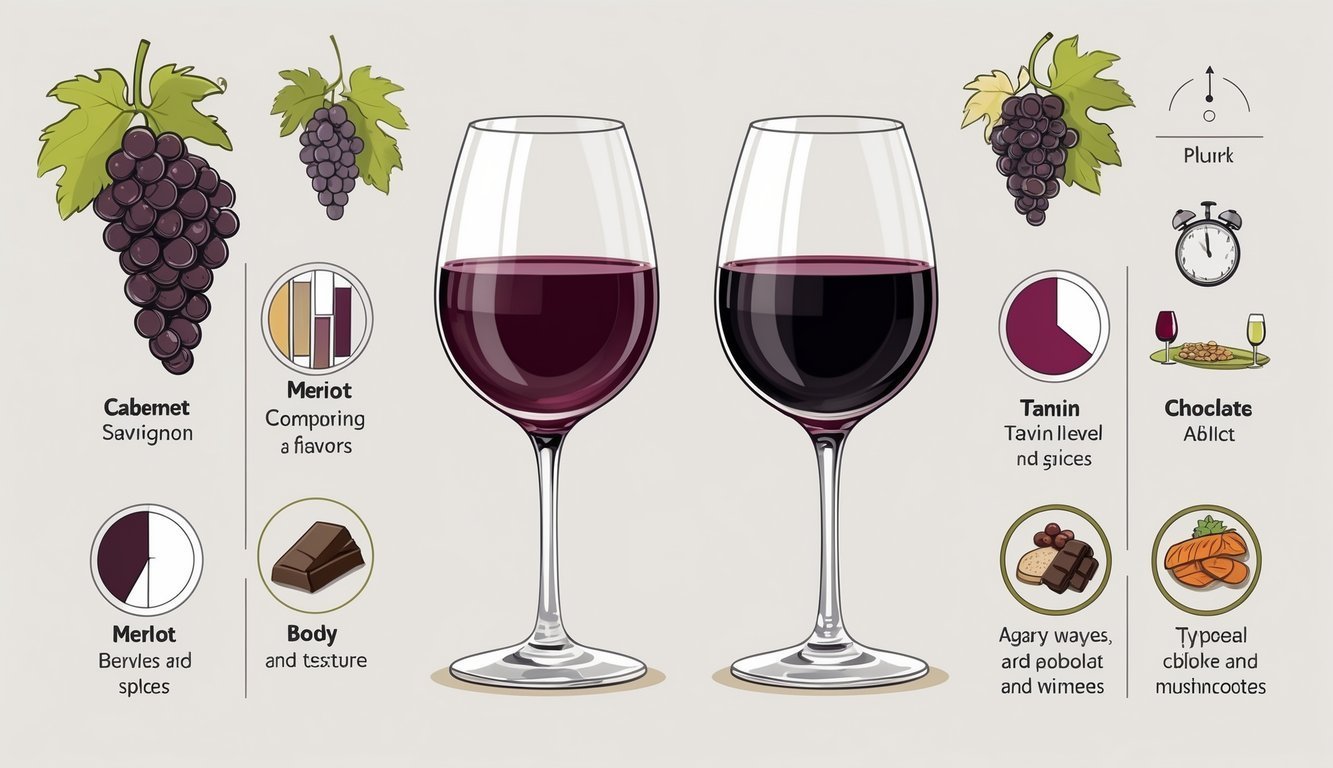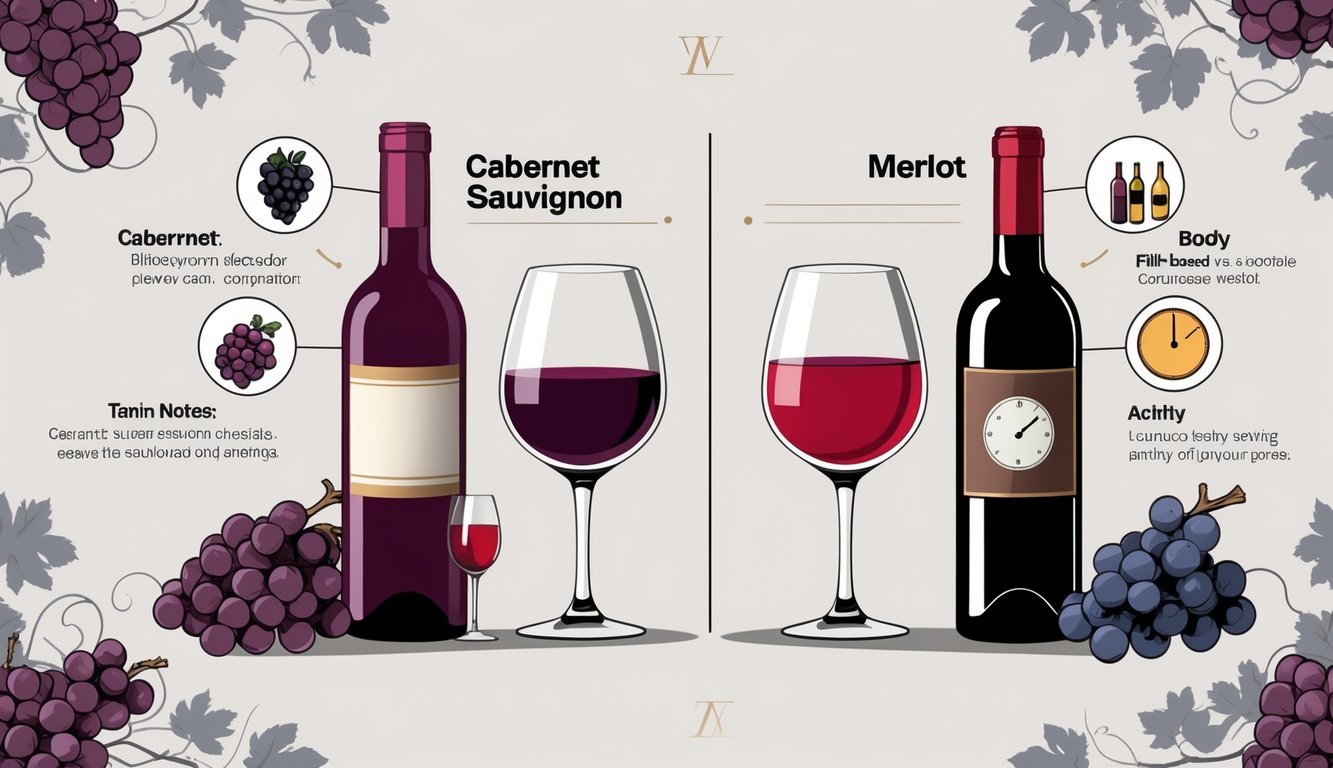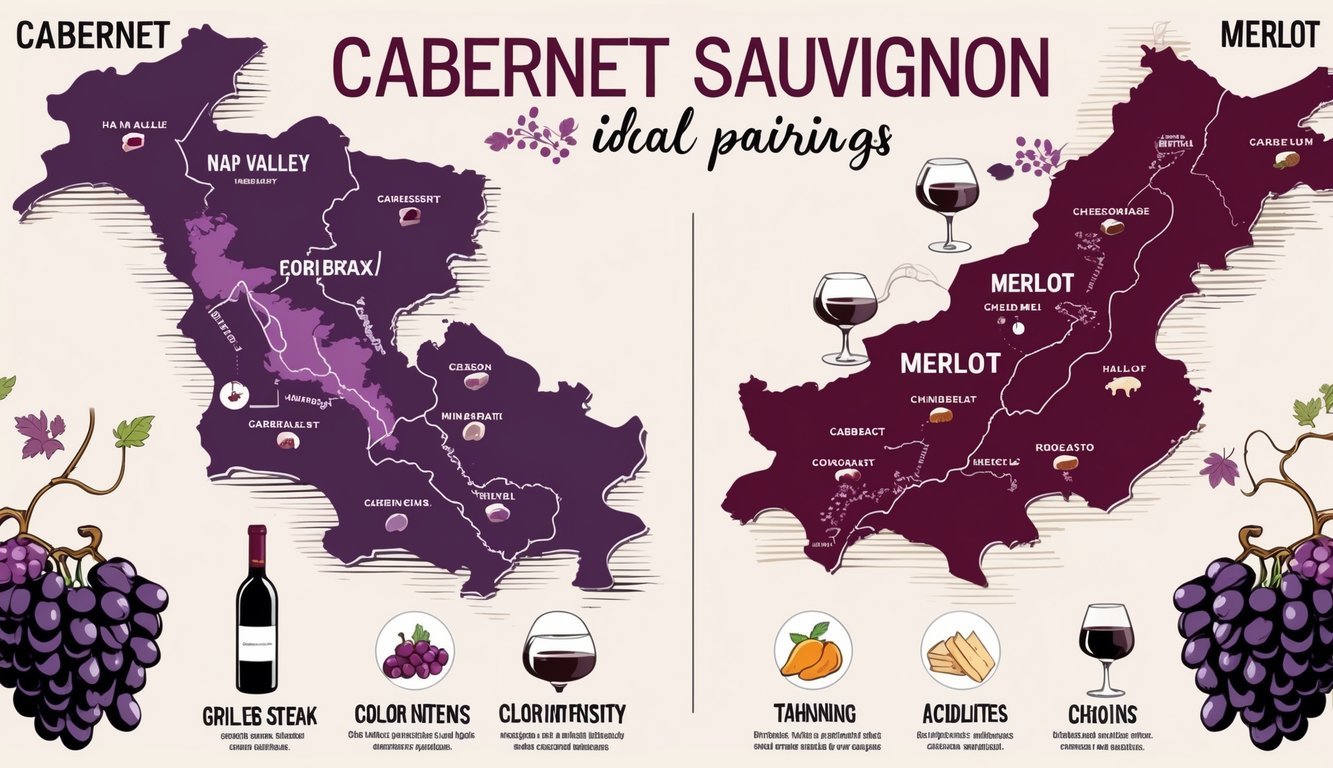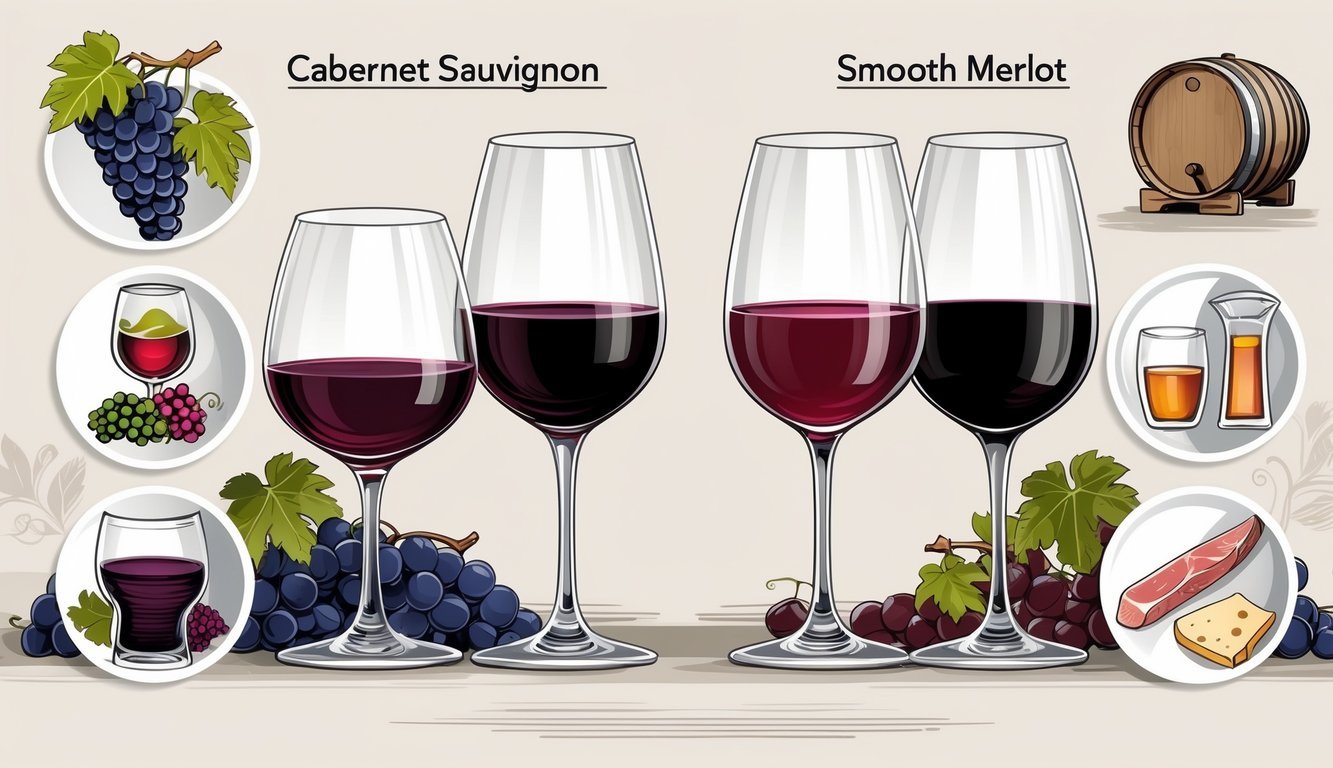PsychNewsDaily Publishers
100 Summit Drive
Burlington, MA, 01803
Telephone: (320) 349-2484
PsychNewsDaily Publishers
100 Summit Drive
Burlington, MA, 01803
Telephone: (320) 349-2484
Cabernet Sauvignon features bold flavors and high tannins, while Merlot is softer, fruitier, and easier to drink, making each suitable for different occasions and pairings.

When you put Cabernet Sauvignon and Merlot side by side, you’re looking at two of the most beloved red wines out there. Cabernet brings bold, structured flavors and packs in higher tannins, while Merlot is softer, fruitier, and honestly just easier to sip. If you know these key details, you’ll have a much easier time picking the wine that fits your mood or meal.
These two wines grow in different climates and have their own quirks, like when they ripen and how they taste. If you get a handle on these six key differences, you’ll feel more confident choosing between them—or even branching out into something new.
Maybe you’ve just started drinking wine, or maybe you’ve been a fan for years. Either way, knowing what sets these two apart is a pretty handy skill.
This guide gets into the facts that every wine lover should know to really appreciate both Cabernet Sauvignon and Merlot.

If you dig into these popular red wine styles, you’ll spot some clear differences in their grapes, flavors, and the way they feel on your palate. You’ll also see how their tannins, acidity, and aging potential set them apart.
Cabernet Sauvignon grapes are small and have thick skins. That gives them strong tannins and a deep, rich color. They take longer to ripen, usually hanging on the vine until late in the season.
This slow ripening lets sugars and flavors develop, especially in warmer climates.
Merlot grapes are bigger and have thinner skins. They ripen earlier, so they end up softer and less astringent. Because their tannins are lower, they feel smoother when you drink them.
Merlot is often easier to grow in cooler regions than Cabernet.
Cabernet Sauvignon hits you with bold flavors—think blackcurrant, black cherry, and sometimes a bit of bell pepper or tobacco. You might pick up hints of vanilla and cocoa, especially if it’s been aged in oak.
This wine usually tastes dry and strong, with some spicy complexity underneath.
Merlot leans fruitier and softer, with flavors like plum, blackberry, and a little chocolate. You’ll get gentle notes of vanilla and spice, but they’re more subtle.
If you like red wine that’s not too intense, Merlot’s approachable vibe might just win you over.
Cabernet Sauvignon is famous for its firm tannins, which give the wine plenty of structure and a bit of astringency. This makes the wine feel fuller-bodied and more robust.
Its acidity sits around moderate, which balances out those rich flavors and helps it age well.
Merlot comes with lower tannins, so it feels softer and smoother in your mouth. Its acidity is usually milder, which makes it rounder and more approachable.
Because of this, Merlot often tastes less dry and is super friendly for casual drinking.
Cabernet Sauvignon’s strong tannins and acidity make it a great candidate for aging. With time in oak barrels and bottles, it develops deeper, more complex flavors—think leather and spice.
Winemakers love using Cabernet in blends or as a single-variety wine when they want a bold style.
Merlot ages well too, but usually peaks sooner. Winemakers often add Merlot to blends to soften them up and bring in fruitiness.
You’ll find Merlot as an easy-drinking young wine, but sometimes it gets some oak aging to add depth.
| Feature | Cabernet Sauvignon | Merlot |
|---|---|---|
| Grape Skin | Thick | Thin |
| Ripening Time | Late | Early |
| Key Flavors | Blackcurrant, tobacco, oak | Plum, blackberry, chocolate |
| Tannin Level | High | Low |
| Body | Full | Medium |
| Aging Potential | Long | Medium |

Cabernet Sauvignon and Merlot grow best in different regions, and you can really taste the difference. Where they come from shapes their flavors and style.
Pairing these wines with the right food can totally change the experience. Comparing them to other wines also helps you figure out what you like best.
Cabernet Sauvignon shines in Napa Valley and Sonoma County in California. The warm climate there helps the grapes build bold tannins and dark fruit flavors.
In France, Cabernet is a big player in Bordeaux blends on the Left Bank, especially in places like Médoc and Pauillac. Here, it brings structure and great aging potential.
Merlot rules Bordeaux’s Right Bank, in areas like Saint-Émilion and Pomerol. The soils are softer, the climate is cooler, and the wines end up rounder and fruitier.
You’ll also spot Merlot in Chile and Washington State, where it usually turns out smooth and easy to drink. Other places to find Merlot include Australia, Argentina’s Mendoza, and Cahors in France.
If you’re picking food, go for Cabernet Sauvignon with rich, hearty dishes. Think grilled beef, roast lamb, or duck.
The wine’s tannins cut through fatty meats and make bold sauces pop. Aged hard cheeses like cheddar or comté also play well with Cabernet.
Merlot’s softer tannins and fruity flavors pair nicely with gentler foods, like roast chicken, pork, or mushroom-based dishes.
It’s a solid match for medium cheeses and pasta with tomato sauces, especially if you toss in some rosemary or other herbs.
Cabernet stands out for its dark fruit and strong tannins. It’s in the same ballpark as Syrah/Shiraz or Malbec, which bring bold flavors but their own twist with spice or fruit.
Merlot’s softness can remind you of Pinot Noir, but Merlot usually has more body and less acidity.
Bordeaux blends often mix Cabernet with Cabernet Franc, Petit Verdot, and Merlot to balance out tannins and flavors.
If you like white wine, you probably won’t get the same experience with these reds, but sometimes a Chardonnay or Sauvignon Blanc can be a nice switch with a meal.
Try out these tips and see what combinations work for you.

Cabernet and Merlot taste different, age in their own ways, and pair with food differently. Where they grow, their tannin levels, body, and acidity all make a difference.
Cabernet Sauvignon usually brings bold flavors with dark fruit like blackcurrant. You might notice some spice and a bit of bitterness from the tannins.
Merlot is softer and fruitier. Expect flavors like plum and dark cherry, with a little chocolate or mild spice thrown in.
Cabernet Sauvignon comes with higher tannins, so it ages longer and gets more complex over the years.
Merlot has lower tannins and feels softer, so it’s often best when it’s young, though some Merlots can age nicely too.
Cabernet works well with rich meats like steak, lamb, and anything with strong flavors. Its tannins really shine with fatty foods.
Merlot pairs up with lighter meats like chicken or pork, plus dishes with mushrooms or gentle spices. It’s pretty versatile and goes with a range of flavors.
You’ll find great Cabernet Sauvignon in Bordeaux’s Left Bank, Napa Valley, and parts of Australia.
Top Merlot usually comes from Bordeaux’s Right Bank, Washington State, and even Italy.
Cabernet has higher tannins, which gives it a firmer structure and more astringency.
Merlot has lower tannins, so it feels softer and smoother on your palate.
Cabernet Sauvignon tends to feel full-bodied, and its higher acidity gives it a sharper edge. This acidity also helps it age well, which is probably why some people love to stash bottles away for years.
Merlot, on the other hand, leans toward medium to full body. It has lower acidity, so you usually get a rounder, softer mouthfeel—definitely less bite than Cabernet.